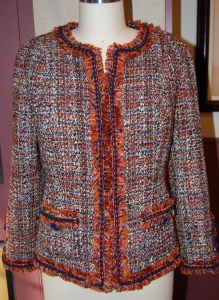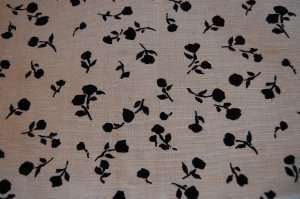Never did I imagine that when I last wrote about the progress on this jacket, it would be an entire month before I could declare it “finished.” But such is a fact of life with the construction of one of these jackets. They always seem to take much longer to complete than ever imagined. (I should remind myself that during that month, I also made a wool skirt and I was away twice on short trips, but still…)
As this is the fifth one I have made, I can safely say that I have developed my own set of tips for working my way through the lengthy construction process. Of course, it all has to start with a pattern which is a perfect fit. Fortunately my muslin pattern is from a Jackets Class I had with Susan Khalje over five years ago. With this pattern, I can go right to my boucle and get started.
While it is often recommended to cut out just the body of the jacket, minus the sleeves (the variegated weave of which is then checked with the constructed jacket body before cutting them out), I have developed enough confidence that I cut out my sleeves along with the body of the jacket. This allows me to make the sleeves first. For me there are two advantages to doing this: 1) there is a psychological benefit in knowing that the sleeves are lined, linings are fell-stitched in place, trim is on, and the sleeves are as finished as they can be before setting them into the body of the jacket, and 2) I like to trim the sleeves first, as a way of testing the trim I have chosen. If I do not like it, I only have trim on one, or two, sleeves which must be removed. It is also much easier to sew trim on a sleeve which is still separate from the jacket.
Another tip I have learned is to use my walking foot not only for the channel quilting of the lining and fashion fabric (a must), but also for all the seams. I pin profusely, but the walking foot helps to keep the fabric from slipping, crucial when matching all those lines and plaids prevalent in a typical boucle weave.

I chose this navy and white silk charmeuse from Britex Fabrics for my lining fabric. The boucle is from Mendel Goldberg Fabrics.
I really went round and round with the trim for this jacket. I knew I wanted to use self-fringe, but I also knew it would need some definition added to it. After trying several colors of velvet and Petersham ribbon in the trough of the fringe, I realized I would have to go to a bright orange as an underlay for the navy twisted braid I wanted to place on top.

The trim was applied in three steps. Here the fringe is attached as the first step. Not too exciting all by itself.

The next step was to apply this bright orange velvet ribbon, also from Britex. It was really a leap of faith to use this very demonstrative color. It looks fairly garish like this! (I sewed each edge of this ribbon separately, so twice around for this part of the trim.)

One thing I have done with all my jackets – and this is a tip from Susan Khalje – is to add about 1/2 inch in length to the center back of the jacket, curving it up gently to the side seams. I love the effect that this little bit of extra curve gives to the back of the jacket.
I always wax and iron the thread which I use for applying the trim. It adds strength, but also is easier with which to work. For this jacket, I also carefully ironed each “level” of trim as I applied it.

A detail of the right pocket. Of course, and this is preaching to the choir, the pockets absolutely cannot be cut out until the body of the jacket is completed. Their placement is a visual determination which really depends upon the fit and appearance of the finished jacket.
I found these vintage buttons in one of my button boxes. I knew I wanted to use dark blue buttons, and I kind of liked the appearance of these.
The only hesitation I had is that they are plastic! It seems a bit of a sacrilege to put plastic buttons on one of these jackets, but I actually think they look okay. If I find other navy blue buttons in my future travels, I might switch them at some point. But right now, they work.

Because I had only 8 buttons, I was limited to two pockets, and three buttons on each sleeve. I probably would not have put four pockets on this jacket anyway, so that was not really a compromise.
I have enough of the boucle left over to make a simple straight skirt, I think. However, that will not happen this year! I am so ready to move on to my next project. In fact, it may be well over a year before I plunge into another one of these jackets. I have but one other boucle lurking about in my fabric closet right now, and I am content to let it stay there for a while.
Now it’s time to tiptoe ever so quietly into the lighter shades and fabrics of early Spring, despite the snow that is currently falling. I am so happy to have this jacket in the “finished” column.














































































































